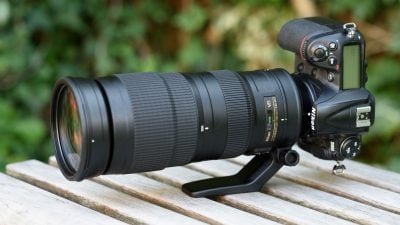Nikon 200-500mm f5.6E VR review
-
-
Written by Thomas
In depth
The Nikkor AF-S 200-500mm f5.6E ED VR is a super-telephoto zoom designed for Nikon DSLRs. Announced in August 2015, it represents a new category in the Nikkor range, offering a super-telephoto range at a comfortably lower price than the existing AF-S 80-400mm f4.5-5.6 VR II not to mention a fraction of the high-end AF-S 200-400mm f4G VR, while out-reaching either of them. Indeed at first glance, the AF-S 200-500mm f5.6E would seem like a response to the popular 150-600mm zoom options from Sigma and Tamron which filled a gap missing from both Nikon and Canon’s catalogues. The price of the new Nikkor is also roughly similar to the higher-end Sports version of Sigma’s 150-600mm, but there are of course differences. Most obviously the Sigma and Tamron 150-600mm lenses start wider and end longer with a 4x range versus just 2.5x on the Nikkor. The Tamron lens is lower-priced too, as is the Contemporary version of the Sigma. On the other side of the coin, the Nikkor features a constant f5.6 focal ratio, compared to the f5-6.3 of the Sigma and Tamron.
The really important question though is which delivers the best quality? To find out I tested the Nikkor AF-S 200-500mm f5.6 against the Tamron 150-600mm, both of the latest Sigma 150-600mm lenses, and for good measure, Nikon’s own AF-S 80-400mm, all on the demanding D810 body. So if you’re shopping for a super-telephoto zoom, you’ve come to the right place!
PS – don’t forget you can support my work next time you order anything at Amazon, B&H or Adorama by first clicking through to them using the links above and in the sidebar. It works for anything you order at any time – thanks for your support!
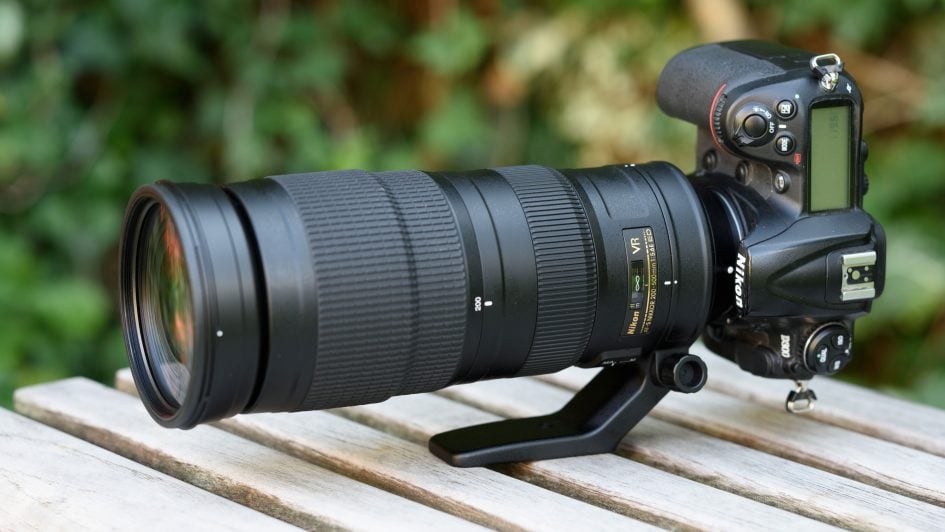
Facts from the catalog
As usual I’ll have a look at the technical data first. I’ve rated the features with a [+] (or [++]), when it’s better than average or even state of the art, a [0] if it’s standard or just average, and [-] if there’s a disadvantage. I’ll compare it mostly with Sigma’s 150-600/5.0-6.3 DG OS HSM Sports (the “150-600 Sports” for short).
Size (diam. x length): 108 x 268mm (4.2 x 10.5in). Add another 91mm for the hefty lens-hood and zoom-in to 500mm focal length (+76mm) and you end up at a total length of 435m (17.1in). But the Sigma 150-600 Sports is still considerably bigger at 121 x 290mm (w/o hood at 150mm focal length) extending to 46 mm (18.3in) with attached lens-hood at 600mm focal length. The Tamron is about the same length, only the Sigma 150-600 Contemporary is a bit shorter. [0]
Weight: 2,300g (81.2oz.). Attach a D810 to it and you’re over 3kg. That’s not easy to carry around on a shoulder-strap all day. The 150-600 Sports weighs a whopping 2,860g and lets you attach straps to the lens. Both the Sigma 150-600 Contemporary and the Tamron come in slightly below 2kg. [0]
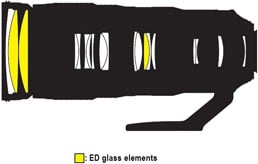
Optics: 19 elements in 12 groups. This is pretty low compared to the 150-600 Sports with 24 elements in 16 groups. The lens has three extra-low dispersion elements but no Nano-coating. [+]
Closest focus distance/max. magnification: 2.2m (7.2ft) / 1:4.5. In my test I could go down to 2.0m / 1:4.0 with manual focusing. That’s a bit better than the 1:5 magnification of the 150-600 Sports (1:4.4 with MF). From a distance of 5m (16.4ft) the magnification of the Nikon is 1:10.0 while the 150-600 Sports reaches 1:9.0. [0]
Filter-thread: 95mm. That’s larger than most of us have filters for and may mean that you need to get new filters for the lens. But that’s par for the course as both the Sigma Contemporary and the Tamron 150-600mm zoom need 95mm filters. The Sigma 150-600 Sports needs 105mm filters which are even more expensive. Only the Nikon 80-400/4.5-5.6 uses standard 77mm filters. [0]
Image Stabilization: Yes. Nikon claims their VR yields 4.5 stops of stabilization. It can be switched off and also offers a “normal” and a “sport” mode. The latter is recommended when tracking moving objects. The competition also has stabilization, dubbed “OS” with Sigma and “VC” with Tamron. [+]
Auto Focus: AF-S with SWM (silent wave motor), so it does work on D3x00/5×00-bodies. Manual-focus override is by simply turning the focus ring. Same with the competition. [+]
Covers full frame/FX or smaller = very good. Same with the competition. [+]
Price: around 1600 EUR new (incl. 19% VAT), same as the 150-600 Sports. Both the Tamron and Sigma 150-600 Contemporary are much cheaper. But Nikon’s own 80-400mm still costs more than 2100 EUR. [-]
Comes with a cheap soft case and a removable tripod-collar. The lens hood is included and reversible for transport, the lens caps are standard Nikon’s. The Sigma 150-600 Sports has a much nicer and well padded lens case and the carton of the lens can be converted to a carrying box. But you can only remove the foot of the tripod-collar. [0]
Distance information is relayed to the camera, so the Nikon body can do all the advanced exposure-related stuff with this lens. Same with the competition. [+]
Aperture ring: no. Same as with all the other alternatives. [0]
Sealing: yes. A rubber grommet at the lens-mount and a rubberized front-end that acts as a seal when the lens-cap is attached. No other measures of sealing are mentioned. Sigma claims its 150-600 Sports to be a “dust and splash-proof construction”. Still I’d rate the Sealing on the Nikon a [+]
The score in the “features-department” is 1[-]/6[0]/6[+]. The minus-point being the high price. All in all there’s not much to differentiate Nikon’s newest offering from the competition. You may prefer its constant aperture of f5.6 but then the lens offers a smaller zoom-range and less reach.
A selection of long zooms
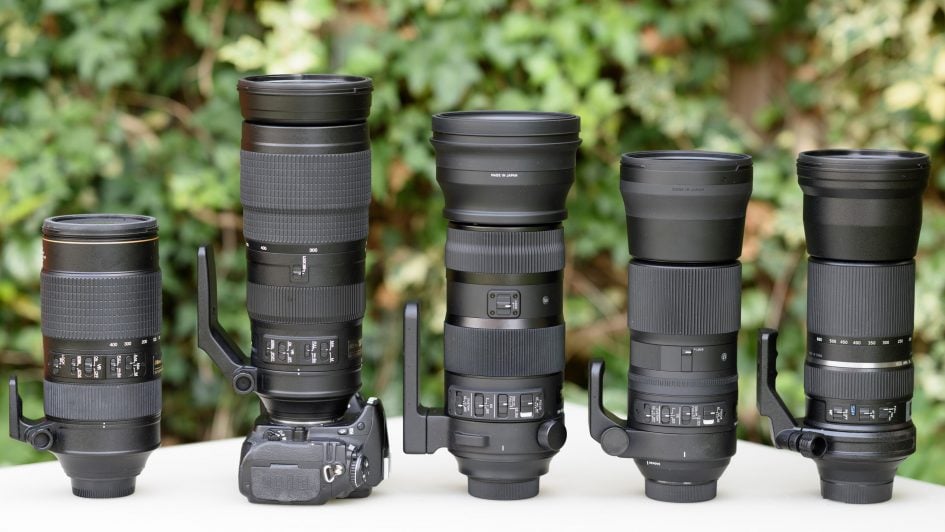
Above from left to right: Nikon 80-400mm + 200-500mm, Sigma 150-600mm Sports + Contemporary, Tamron 150-600mm
Here is the angle of view that the Nikon covers with its 2.5x zoom:
Nikon 200-500mm coverage on Nikon D810 (FX) body

Above left: at 200mm, above right: at 500mm
A 150-600mm zoom like the Sigma 150-600mm “Contemporary” shown below covers a 4x zoom range. It captures a 25% wider vista on the short end and reaches 20% further than the Nikon at the long end.
Sigma 150-600mm “Contemporary” coverage on Nikon D810 (FX) body

Above left: at 150mm, above right: at 600mm
You can crop 20% into the 500mm shot from the Nikon to get the same angle of view as with the longer zooms at 600mm. This sheds 36% of your pixels, which is equivalent to reducing a 36MP shot on a D810 body to 23MP – which probably is still enough for most purposes. Or you use a teleconverter and zoom in to 600mm.
On the short end the options are are less convenient/realistic: Either you step back (in the case of the image above you need to get 1km further away) which changes the perspective and in many cases is simply unpractical. Or you do a two-shot panorama at 200mm.
Alternatives:
– Sigma offers a lot of lenses in this category: Their latest is the 150-600mm F5-6,3 DG OS HSM Contemporary (1100 EUR, review coming soon), then there is the 150-600mm F5-6,3 DG OS HSM Sports (around 1600 EUR, see Gordon’s Sigma 150-600mm Sport review). Plus the 150-500mm f/5-6.3 DG OS HSM (around 700 EUR, see my Sigma 150-500mm f/5-6.3 review) and the 50-500mm 4.5-6.3 DG APO OS HSM which has the largest zoom-range of all alternatives and goes for around 1000 EUR.
– From Nikon there’s the AF-S 80-400mm f4.5-5.6D ED VRii. Read about this lens in my Nikon 80-400mm review.
– From Tamron there is the SP 150-600mm F/5-6.3 Di VC USD A011 (around 800 EUR) and their new 2nd generation SP 150-600mm F/5-6.3 Di VC USD G2 (around 1300 EUR, see my Tamron 150-600mm review). Plus they have the non-stabilized SP AF 200-500mm F/5-6.3 Di LD [IF] still on offer (see my Tamron 200-500mm impressions).
Focus, build quality, and image stabilization
Focus accuracy and repeatability is critical to consistently produce sharp shots. Repeatability (the accuracy of focus on the same subject after repeated focus-acquisition) of this lens is very good (measured 97,2% in FoCal) with no outliers over a series of 40 shots. And there is no performance variation whether the lens focuses from infinity or from a closer distance. At 500mm focal length the lens focuses in around 1 sec from infinity to 5m, which is slow. One reason is that the lens starts searching in the wrong direction (beyond infinity) before turning around. That happens at focal lengths longer than 300mm and only when the previous focus was close to infinity. At 300mm the lens focuses in about 0.7 sec from infinity to 5m which is good. The lens offers a focus limiter which can be set to “full” or “infinity – 6m” to prevent the AF from hunting in the foreground – but that doesn’t prevent the afore-mentioned effect of hunting beyond infinity.
The focus ring has some slack/play between its movement and the focus-action and a long throw of 170 degrees. The 29mm broad focus ring is easy to grip and movement is very smooth. The zoom-ring is very broad at 69mm and moves easily so it’s no wonder the lens is prone to creep. Fortunately there’s a zoom lock at 200mm to prevent that. But that doesn’t help to keep focal-length stable at other settings.
AF-operation is barely audible from the outside, and if you record video with the built-in microphone every focus-movement starts with a slight “click” and the AF-drive is very quiet. The VR-system is virtually silent both on the outside and when recording video. Shaking the lens produces almost no noises but the lens hood is not a tight fit and rattles a bit.
The tripod-collar and mount weighs 208g and looks much sturdier than the flimsy collar of the Nikon 80-400mm zoom. It can be completely removed from the lens when you’ve detached the lens from the camera. Unfortunately my tests showed that the shutter slap of the D810 still introduces unwanted blur at shutter speeds around 1/25. So be careful and use electronic first curtain to eliminate this source of shake if you shoot from a tripod.
In general the impression of build quality is that of an upmarket/enthusiast albeit not pro-level lens: A high quality metal/plastic construction combined with a weather sealed metal lens-mount, and nine rounded aperture blades.
To test the effectiveness of the image stabilization I did a series of 100 test-shots hand-held at 500mm focal length. Shutter speeds were from 1/500 of a second down to 1/60 sec. Comparing the shots with VR=ON with a reference sample of 20 shots at 1/500 sec with VR=OFF I can report that the VR is good for at least 2 stops of image-stabilization with the number of usable shots at 1/60 (3 stops) still pretty high.
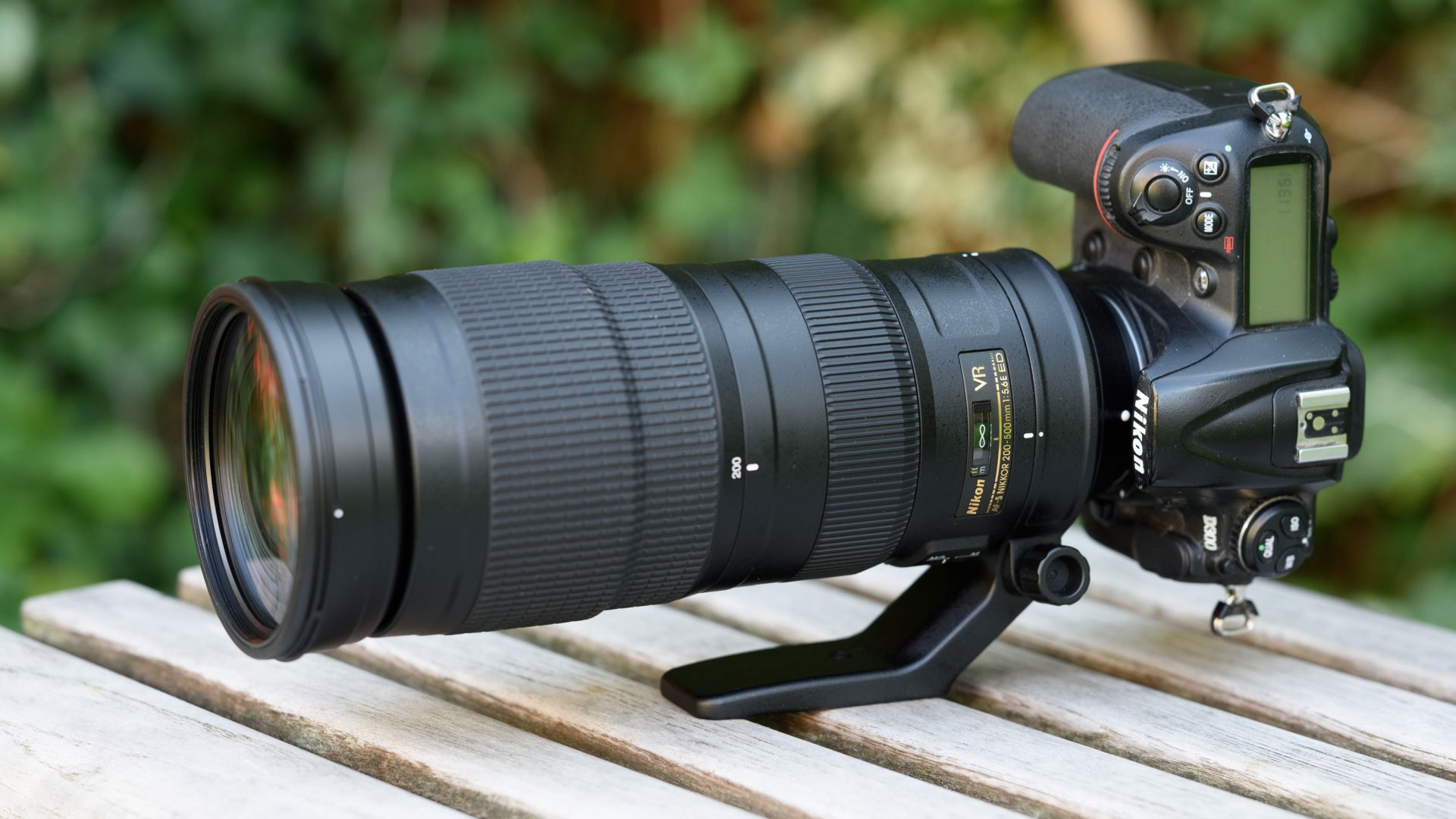
 The best image quality in its class combined with a reasonable price, a good image stabilization, and an acceptable size and weight earns Nikon's new 2.5x super-telephoto a Highly Recommended rating. Good points: Very good quality over 36Mp full-frame, even wide open; good image stabilization; constant f/5.6 focal ratio; works well with 1.4x teleconverter; weather sealing; quiet, fast, and precise AF operation; maximum magnification of 1:4.0 in MF. Bad points: Not the cheapest super-telephoto zoom; not the lightest lens in its class; only 2.5x zoom range.
The best image quality in its class combined with a reasonable price, a good image stabilization, and an acceptable size and weight earns Nikon's new 2.5x super-telephoto a Highly Recommended rating. Good points: Very good quality over 36Mp full-frame, even wide open; good image stabilization; constant f/5.6 focal ratio; works well with 1.4x teleconverter; weather sealing; quiet, fast, and precise AF operation; maximum magnification of 1:4.0 in MF. Bad points: Not the cheapest super-telephoto zoom; not the lightest lens in its class; only 2.5x zoom range.



